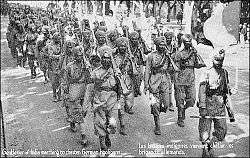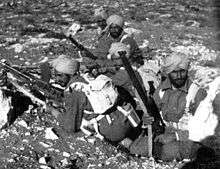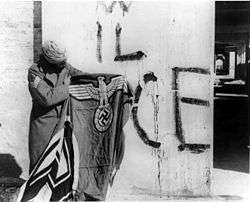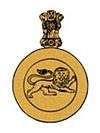Sikh Regiment
| The Sikh Regiment | |
|---|---|
|
The Regimental Insignia of the Sikh Regiment | |
| Active | 1 August 1846–Present |
| Country |
|
| Branch | Indian Army |
| Type | Line Infantry |
| Role | Infantry |
| Size | 19 battalions |
| Motto(s) | Nischay Kar Apni Jeet Karon (With determination, I will be triumphant). |
| War Cry | Bole So Nihal, Sat Sri Akal (Victory belong to those; Who recite the name of God with a true Heart) |
| Anniversaries | September 12, 1897 (the day of the Battle of Saragarhi) is celebrated as the Regimental Battle Honour Day. |
| Decorations | 21 Indian Order of Merits ,14 Victoria Crosses, 2 Param Vir Chakras, 2 Ashoka Chakras, 14 Maha Vir Chakras, 14 Kirti Chakras, 64 Vir Chakras, 15 Shaurya Chakras, 75 Sena Medals and 25 Vishisht Seva Medals and "Unit Citation" to 8th Battalion for their meritorious and gallant performance during the isolation of Tiger Hill in the Kargil Skirmish |
| Insignia | |
| Regimental Insignia | Sharp-edged Quoit, or Chakra, which the Khalsa Armies had used in combat. The Chakra rings a lion, symbolic of the name (Singh) every Sikh carries |
The Sikh Regiment is a 19 battalion strong, infantry regiment of the Indian Army, drawing a bulk of its recruits from the Sikh community. It is the most decorated regiment in the Indian army and was at one stage one of the highest decorated regiments in the British Empire. The first battalion of the regiment was officially raised just before the annexation of the Sikh Empire on August 1, 1846, by the British Empire. The Sikh Regimental Centre is located in Ramgarh Cantonment, 30 km (19 mi) from Ranchi, which is the capital of the state of Jharkhand in India. The Centre was earlier located in Meerut in the state of Uttar Pradesh.
The modern Sikh Regiment traces its roots directly from the 11th Sikh Regiment of the British Indian Army. When transferred to the Indian Army like its sister regiments, the numeral prefix (in the case of the Sikh Regiment, 11) was removed and extra battalions were raised, transferred or disbanded to meet army needs. With a humble beginning of two battalions, today the fraternity has grown to a regiment of 19 regular infantry and two reserve battalions strong.
Recruitment
Enlisted soldiers are strictly recruited from the Sikh community from Punjab & her surrounding states. They trained internally by the regiment, in which they tend to spend most of their careers. While officers are trained externally from either IMA, or NDA and tend to leave the regiment subject to promotion, officers assigned to the Sikh Regiment are drawn from all regions and areas of India. The war cry of regiment, taken from Sikh scriptures is: 'Jo Bole So Nihal, Sat Sri Akal' ('whoever utters (the phrase following) shall be happy(fulfilled), true is the Holy God').
In a departure from the single class composition, a battalion, 13 Sikh was raised with multiple class composition: a company each of Sikhs, Dogras, Garhwalis and South Indians. However these units were reverted to their original class composition later.
Units
- 2nd Battalion
- 3rd Battalion
- 4th Battalion
- 5th Battalion
- 6th Battalion
- 7th Battalion
- 8th Battalion
- 10th Battalion
- 11th Battalion
- 13th Battalion
- 14th Battalion
- 16th Battalion
- 17th Battalion
- 18th Battalion
- 19th Battalion
- 20th Battalion
- 21st Battalion
- 22nd Battalion
- 23rd Battalion
- 124 Infantry Bn Territorial Army (Sikh)
- 152 Infantry Bn Territorial Army (Sikh)
- 157 Infantry Bn Territorial Army (Sikh) (Home and Hearth)
Others
- 1st Battalion is now 4th Mechanised Infantry.
- 9th Battalion was disbanded in 1984
Awards and citations
The Museum of the Regimental Centre displays a record of the Sikh Regiment in four halls viz.,
- The Religious/motivational Hall,
- The Hall of Heritage,
- The Regimental Glory Hall
- The Peripheral Gallery.
The Chief of Army Staff (COAS) made a special instant award of "Unit Citation" to 8th Battalion, The Sikh Regiment for their meritorious and gallant performance in isolation of Tiger Hill, which facilitated the capture of Tiger Hill top and Helmet and India Gate, features to the West of Tiger Hill top, on night 07/8 July 1999, in Dras.
During Operation Vijay 1999 during Indo-Pak Kargil War, the units of the regiment displayed sterling performance marked with exceptional valour and grit in the face of the enemy.
In all, the Regiment has to its credit 1652 gallantry awards and honours including
- 2 Param Vir Chakras
- Lance Naik Karam Singh in 1948 during Indo-Pakistani War of 1947.
- Subedar Joginder Singh during the Sino-Indian War of 1962.
- 14 Maha Vir Chakras (MVC)
- 68 Vir Chakras.
- 2 Ashoka Chakras.
- 14 Victoria Crosses
- 21 Indian Order of Merits: from Battle of Saragarhi
In addition it has also earned:
- 73 battle honours
- 38 theatre honours besides five COAS Unit Citation, including
- the one bestowed upon 8 Sikh during the 1999 Kargil episode
- and two "Bravest of the Brave" citations.
Battle honours and theatre honours
Battle honours
- Pre-Independence
- Lucknow 1857-58 1 SIKH
- Defence of Arrah 1857 3 SIKH
- Bihar 1857 3 SIKH
- China 1860-62 2 SIKH
- Ali Masjid 1878 1, 3 SIKH
- Ahmed Khel 1880 2 SIKH
- Afghanistan 1878-79 1 SIKH
- Afghanistan 1878-80 2, 3 SIKH
- Kandhar 1880 2 SIKH
- Saukin Wind 1885 2 SIKH
- Battle of Tofrek 1885 2 SIKH
- Manipur 1891 4 SIKH
- Defence of Chitral 1895 1 SIKH
- Chitral 1895 2 SIKH
- Samana 1897 4 SIKH
- Saragarhi/Gulistan 1897 4 SIKH
- Punjab Frontier 1897 2, 3, 4 & 35 SIKH (SRC)
- Malakand 1897 3 & 35 SIKH (SRC)
- Tirah 1897-98 2 & 4 SIKH
- China 1900 1 SIKH
- North-West Frontier 1908 3 SIKH
- World War I

- La Bassée 1914 2 & 5 SIKH
- St-Julien 1914 2 & 5 SIKH
- Armentières 1914-15 5 SIKH
- Auber 1914 2 & 5 SIKH
- Givens 1914 4 SIKH
- Siege of Tsingtao (China) 1914 4, 5 SIKH
- Neuve Chapelle 1914-15 2, 3 & 5 SIKH
- France and Flanders 1914-15 2 & 5 SIKH
- Suez Canal 1914-15 1 SIKH
- Festubert 1915 2 SIKH
- Tigris 1916 3 & 5 SIKH
- Pyres 1915 2 & 4 SIKH
- Sari Bair 1915 1 SIKH
- Hells 1915 1 SIKH
- Krishna 1915 1 SIKH
- Suva 1915 1 SIKH
- Gallipoli 1915 1 SIKH
- Egypt 1915 1 SIKH
- Mesopotamia 1916-18 1,3 & 4 SIKH
- Sharon 1918 5 SIKH
- Palestine 1918 5 SIKH
- Baghdad 1916-18 5 SIKH
- Siege of Kut 1917 1,3 & 5 SIKH
- Hai 1917 3 & 4 SIKH
- Megiddo 1918 5 SIKH
- Persia 1918 4 SIKH
- Egypt 1918 2 & 3 SIKH
- Sharot 1918 2 SIKH
- Inter-War years
- North West Frontier(now Khyber Pukhtunkhwa) 1918-19 35 (SRC) & 5 SIKH
- Afghanistan 1919 2 & 35 SIKH (SRC)
- Palestine 1921 35 (SRC) & 5 SIKH
- Second World War


- Agordat 1940-41 4 SIKH
- Keren 1941 4 SIKH
- First Battle of El Alamein 1940-43 4 SIKH
- Omars 1941 4 SIKH
- Kuantan 1941-42 5 SIKH
- Niyor Kluang 1941-42 5 SIKH
- Mersa Matruh 1941-42 2 SIKH
- Kota Bharu 1942 5 SIKH
- North Arakan 1942-45 1 SIKH
- Buthidaung 1942-45 1 SIKH
- Coriano 1943-45 2 SIKH
- San Mariano 1943-45 2 SIKH
- Poggio San Giovanni, Italy1943-45 2 SIKH
- Monte Calvo (Picentini) 1943-45 4 SIKH
- Battle of Imphal,Kangla Tongbi 1944 1 SIKH
- Gothic Line 1943-45 4 SIKH
- Nyaungu Bridgehead 1945 1 SIKH
- Irrawaddy River 1945 1 SIKH
- Shandatgyi 1945 1 SIKH
- Kama 1945 1 SIKH
- Sittang 1945 1 SIKH
- Post-Independence
- Srinagar 1947 1 SIKH
- Tithwal 1948 1 SIKH
- Raja Picquet 1965 2 SIKH
- Burki 1965 4 SIKH
- Op Hill 1965 7 SIKH
- Siramani 1971 4 SIKH
- Defence of Poonch 1971 6 SIKH
- Purbat Ali 1971 10 SIKH
- Tiger Hill 1999 8 SIKH
Theatre honours
- Pre-Independence
- North Africa 1940-43 2 & 4 SIKH
- Abyssinia 1940-41 4 SIKH
- Iraq 1941 3 SIKH
- North Africa 1941-42 3 SIKH
- Malaya 1941-42 5 SIKH
- Burma 1942-45 1 SIKH
- Italy 1943-45 2 & 4 SIKH
- Greece 1944-45 2 SIKH
- Post-Independence
- Jammu & Kashmir 1947-48 1,5,7 & 16 SIKH
- Jammu & Kashmir 1965 2,3 & 7 SIKH
- Punjab 1965 4 SIKH
- Sindh 1971 10 SIKH
- Punjab 1971 2 SIKH
- East Pakistan 1971 4 SIKH
- Jammu & Kashmir 1971 5 & 6 SIKH
- Kargil 1999 8 SIKH
- Others
- The 1st Sikh battalion, in 1979 was the British Commonwealth's most decorated battalion (245 pre-independence and 82 post-independence gallantry awards), when it was transformed into the 4th mechanized infantry.[1]
- The Sikh regiment is the highest decorated regiment of the Indian army as per Defence review annual as on 1995-1996.[2][3]
Plans to raise a UK Sikh regiment
Advanced plans by the British Army to raise a UK Sikh infantry regiment were scrapped due to accusations by the Commission for Racial Equality (CRE) that such a creation could be viewed as racist or sectarian. The Sikh regiment had many supporters including Prince Charles.[4]
Alliances
References
- ↑ [ Global security |http://www.globalsecurity.org/military/world/india/army-equipment-mech.htm ]
- ↑ [ Defence review|http://mod.nic.in/samachar/18/html/ch8.htm ]
- ↑ [Sikh review|http://www.sikhreview.org/pdf/october1996/pdf-files/gallantry.pdf ]
- ↑ "UK Sikh regiment". Telegraph.co.uk. Archived from the original on November 18, 2007. Retrieved 26 November 2014.
Bibliography
- 1st King George V's own battalion,: The Sikh Regiment
- A Legacy of Valour - An Illustrated History of the Sikh Regiment (1846-2010). Ramgarh: The Sikh Regiment Officers' Association, 2011, ISBN 978-81-905619-7-6.

